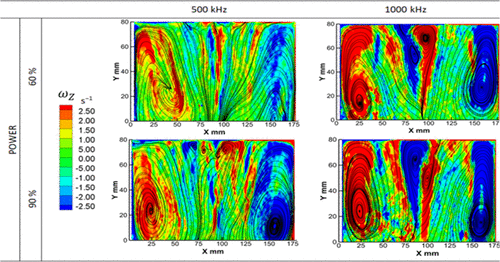当前位置:
X-MOL 学术
›
Ind. Eng. Chem. Res.
›
论文详情
Our official English website, www.x-mol.net, welcomes your feedback! (Note: you will need to create a separate account there.)
Evaluation of the Hydrodynamic Performance of High-Frequency Sonoreactors Using PIV
Industrial & Engineering Chemistry Research ( IF 4.2 ) Pub Date : 2020-09-03 , DOI: 10.1021/acs.iecr.0c02702 Gabriela Rivadeneyra-Romero 1, 2 , Claudia Gutiérrez-Torres 1 , Israel González-Neria 3 , Alejandro Alonzo-García 4 , Juan A. Yáñez-Varela 3 , Víctor Mendoza-Escamilla 3 , Jose A. Jimenez-Bernal 1 , Sergio A. Martínez-Delgadillo 3
Industrial & Engineering Chemistry Research ( IF 4.2 ) Pub Date : 2020-09-03 , DOI: 10.1021/acs.iecr.0c02702 Gabriela Rivadeneyra-Romero 1, 2 , Claudia Gutiérrez-Torres 1 , Israel González-Neria 3 , Alejandro Alonzo-García 4 , Juan A. Yáñez-Varela 3 , Víctor Mendoza-Escamilla 3 , Jose A. Jimenez-Bernal 1 , Sergio A. Martínez-Delgadillo 3
Affiliation

|
In this work, the influence on the flow behavior produced by different operating conditions (varying power dissipation of 300 and 450 W, that is, 60 and 90% of maximum power and two frequencies of 500 and 1000 kHz) in sonoreactors was experimentally characterized by 2D-PIV (particle image velocimetry) technique. Based on the experimental measurements performed at the different operational conditions of power and frequency, the velocity fields produced by the interaction of twelve piezoelectrics operating at the same time were obtained. The vorticity and Reynolds distribution maps at different operating conditions were also obtained. The axial circulation time (tax) was experimentally measured showing a significant decrease for higher power and frequency levels. The fastest tax obtained was 5.79 s. Energy efficiency and the specific power consumption (P/V) were also estimated at both ultrasonic frequencies and powers. Energy efficiency showed a strong dependence on specific power consumption. Distinctive recirculation patterns defined by two large lateral loops interacting with other less energetic were identified. A dimensionless number (NQP(z)) that measures the ratio between the axial flow rate (Qax(z)) and ultrasonic power (Pus) is proposed. The experimental PIV measurements showed that velocity components aligned to the acoustic streaming, prevailed over perpendicular components. Highest velocities were reached at 1000 kHz and increased with ultrasonic power. At this frequency, the highest efficient axial circulation was reached and the shorter mixing times θ95 and tax were obtained.
中文翻译:

利用PIV评估高频电声反应器的水动力性能。
在这项工作中,通过实验表征了在不同的工作条件(300和450 W的变化功率损耗,即最大功率的60%和90%,以及两个频率分别为500和1000 kHz)下对流动行为产生的影响,其特征在于2D-PIV(粒子图像测速)技术。基于在功率和频率的不同操作条件下进行的实验测量,获得了由同时工作的十二个压电体相互作用产生的速度场。还获得了在不同操作条件下的涡度和雷诺分布图。实验测量了轴向循环时间(t ax),结果表明,功率和频率越高,轴向循环时间就越明显。最快Ť获得的ax为5.79s。还在超声波频率和功率下估算了能源效率和单位功耗(P / V)。能源效率显示出对单位功耗的强烈依赖。确定了由两个较大的侧向回路与其他较不活跃的相互作用所定义的独特的再循环模式。无量纲数(N QP(z))用于测量轴向流量(Q ax(z))与超声功率(P us)。实验性PIV测量表明,与声流对齐的速度分量高于垂直分量。最高速度达到1000 kHz,并随超声功率的增加而增加。在此频率,最高有效的轴向循环达到和更短的混合时间θ 95和吨斧获得。
更新日期:2020-10-07
中文翻译:

利用PIV评估高频电声反应器的水动力性能。
在这项工作中,通过实验表征了在不同的工作条件(300和450 W的变化功率损耗,即最大功率的60%和90%,以及两个频率分别为500和1000 kHz)下对流动行为产生的影响,其特征在于2D-PIV(粒子图像测速)技术。基于在功率和频率的不同操作条件下进行的实验测量,获得了由同时工作的十二个压电体相互作用产生的速度场。还获得了在不同操作条件下的涡度和雷诺分布图。实验测量了轴向循环时间(t ax),结果表明,功率和频率越高,轴向循环时间就越明显。最快Ť获得的ax为5.79s。还在超声波频率和功率下估算了能源效率和单位功耗(P / V)。能源效率显示出对单位功耗的强烈依赖。确定了由两个较大的侧向回路与其他较不活跃的相互作用所定义的独特的再循环模式。无量纲数(N QP(z))用于测量轴向流量(Q ax(z))与超声功率(P us)。实验性PIV测量表明,与声流对齐的速度分量高于垂直分量。最高速度达到1000 kHz,并随超声功率的增加而增加。在此频率,最高有效的轴向循环达到和更短的混合时间θ 95和吨斧获得。


























 京公网安备 11010802027423号
京公网安备 11010802027423号